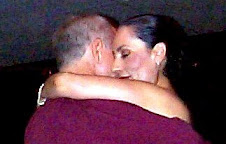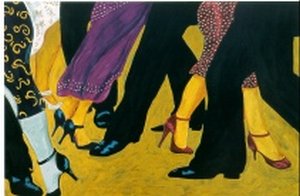The Elements of Style"If you can't see it, you can't dance it."
In the process of going through the many hours of video we took in Buenos Aires, I found that patterns began to emerge. Although each of the dancers had their own different style, certain common markers of good technique kept showing up. A serious student who can develop a mental picture of these key elements and practice them with the aid of a mirror should move to a new level. After all, if the milongueros were able to learn tango by watching each other dance, shouldn’t we be able to do the same? Please keep in mind that these pictures weren’t selected for their artistic quality. They are pictures of every day milonga dancing, not performances or demonstrations. Here are the three essential elements of good technique:
Always place each foot directly in front of the other when walking.Lead with the chest, especially when moving forward from a stop. Step solidly onto a straight leg... never onto a bent knee.
Los Bailarines: (Top row) Tete y Alej, Blas y Graciela, Napo y Lili( Second row) Blas y Graciela, Norberto y Victoria, Ismael El Jalil( Bottom row) Tete y Sylvia, Blas y Elba, Ismael
Walking with the weight forward (2) and stepping with weight onto a straight leg (3) is hard to learn—but it’s what gives tango its characteristic look. Dancers who do it naturally are sometimes spoken of in the milongas as being “muy autentico” or “muy Argentino”.
Friday, November 28, 2008
Wednesday, November 19, 2008
Milonguero a history
Now a days Salon and Milonguero have become more interchangeable in
describing the more vaguely defined styles of a now older generation. They are now allied in beingcontrasted to the stage fantasy tangos, inside and out of Argentina, and foreign social dance forms.
Hence, dancers from each of these two major stylistic groups in Buenos Aires today refer to what they do at their most elegant, i.e. when walking the salon as opposed to showing off figures, as either Salon or Milonguero. It is a matter of oral history. What words you use to describe what depends on who you learned from first. But history marches on, and the meaning of these words seems to be diverging again.
The modern proponents of the style from the North West are all first or second generation followers of the early group led by Petroleo . This group includes the social dancers, Fino and Miguel Balmeceda (passed on), and Juan Bruno and Mingo Pugliese (living). The fantasy
artists including Todaro and Virulazo (both passed away), many performers still working from the Copes generation and many important youngsters. They all seem to be most comfortable calling the root of what they do Salon Tango, although Lampazo, for example, still uses
Milonguero to describe this style, while Juan Bruno continues to insist on dividing this style into Salon and Orillero styles.
Then along came Pedro Rusconi, "Tete" (the first proponent of the close embrace to arise to prominence as a teacher) and Susana Miller, who has coaxed several other milongueros of this style to teach with her. They all would be comfortable with salon as the label for their style, but
most people in Buenos Aires are calling it milonguero style.
So, for the most part, the salon and orillero styles of Devoto have become combined into salon style tango. The closer embrace style, which went untaught for longer, has taken milonguero style tango by default.
Nobody yet is talking about the style of the south or of the neighborhoods ringing the capital, where the younger Argentines often go on their own spelunking expeditions. One thing that I am
sure of is that these neighborhoods offer fertile ground for further explorations in Buenos Aires.
As for myself, while I have been attracted to all these distinct "styles" of tango as I've seen them danced in Buenos Aires, I have not yet formed personal preferences for any of them. I didn't even start noticing close embrace, "Milonguero", style until I'd been in Buenos Aires for a while. It took several years to get past being fascinated with the steps, which were my first draw to the dance. The dancers who were doing less footwork were uninteresting to me and I just didn't see them. Then, years of milonguero advice to feel the dance, not just learn steps began to take effect. I started to notice the dancers for how they stood, embraced and felt the music. It isn't like I didn't know about these things before, I just didn't see them even though they were right in front of me.
I awakened when I saw Tete dance. I watched him for two years without ever being able to steal a single step or copy his style, but with great envy for his ability to express the tango feeling, sensuality and music. He could do this with his partner Maria, Mingo's wife Ester, who is a mistress of the other style, and a plethora of young tango starlets.
Two years ago Tete began to teach, albeit with all the pedagogical glitches of a beginner teacher, and I finally had a chance to get into it. Here was a style that challenged from the inside out. If I couldn't make heart-to-heart contact I couldn't dance. As I made my first breakthroughs I started to gain a much deeper understanding of what I call
tango trance, that is the state in which one dances a set at the milonga in a timeless space. Becoming one with the music and my partner was no longer an abstract, intellectual concept to be related somehow to my footwork. The music in its simplest syncopation, came into focus as the
basis for my connection with my partner. After that experience in milonguero style my other tangos have also improved. My "salon tango"
is ever richer as I learn to stand tall and make elegant my footwork and musicality. My "Orillero tango" keeps offering more and more complexity and variation as I improve my strength, agility,
and concentration. It is also easier to try the vintage canyengue styles and, several distinctive versions of milonga. Most importantly, I am winning the sensual attention of the good dancers I
partner. by Daniel Trenner founder of Bridge to the tango
describing the more vaguely defined styles of a now older generation. They are now allied in beingcontrasted to the stage fantasy tangos, inside and out of Argentina, and foreign social dance forms.
Hence, dancers from each of these two major stylistic groups in Buenos Aires today refer to what they do at their most elegant, i.e. when walking the salon as opposed to showing off figures, as either Salon or Milonguero. It is a matter of oral history. What words you use to describe what depends on who you learned from first. But history marches on, and the meaning of these words seems to be diverging again.
The modern proponents of the style from the North West are all first or second generation followers of the early group led by Petroleo . This group includes the social dancers, Fino and Miguel Balmeceda (passed on), and Juan Bruno and Mingo Pugliese (living). The fantasy
artists including Todaro and Virulazo (both passed away), many performers still working from the Copes generation and many important youngsters. They all seem to be most comfortable calling the root of what they do Salon Tango, although Lampazo, for example, still uses
Milonguero to describe this style, while Juan Bruno continues to insist on dividing this style into Salon and Orillero styles.
Then along came Pedro Rusconi, "Tete" (the first proponent of the close embrace to arise to prominence as a teacher) and Susana Miller, who has coaxed several other milongueros of this style to teach with her. They all would be comfortable with salon as the label for their style, but
most people in Buenos Aires are calling it milonguero style.
So, for the most part, the salon and orillero styles of Devoto have become combined into salon style tango. The closer embrace style, which went untaught for longer, has taken milonguero style tango by default.
Nobody yet is talking about the style of the south or of the neighborhoods ringing the capital, where the younger Argentines often go on their own spelunking expeditions. One thing that I am
sure of is that these neighborhoods offer fertile ground for further explorations in Buenos Aires.
As for myself, while I have been attracted to all these distinct "styles" of tango as I've seen them danced in Buenos Aires, I have not yet formed personal preferences for any of them. I didn't even start noticing close embrace, "Milonguero", style until I'd been in Buenos Aires for a while. It took several years to get past being fascinated with the steps, which were my first draw to the dance. The dancers who were doing less footwork were uninteresting to me and I just didn't see them. Then, years of milonguero advice to feel the dance, not just learn steps began to take effect. I started to notice the dancers for how they stood, embraced and felt the music. It isn't like I didn't know about these things before, I just didn't see them even though they were right in front of me.
I awakened when I saw Tete dance. I watched him for two years without ever being able to steal a single step or copy his style, but with great envy for his ability to express the tango feeling, sensuality and music. He could do this with his partner Maria, Mingo's wife Ester, who is a mistress of the other style, and a plethora of young tango starlets.
Two years ago Tete began to teach, albeit with all the pedagogical glitches of a beginner teacher, and I finally had a chance to get into it. Here was a style that challenged from the inside out. If I couldn't make heart-to-heart contact I couldn't dance. As I made my first breakthroughs I started to gain a much deeper understanding of what I call
tango trance, that is the state in which one dances a set at the milonga in a timeless space. Becoming one with the music and my partner was no longer an abstract, intellectual concept to be related somehow to my footwork. The music in its simplest syncopation, came into focus as the
basis for my connection with my partner. After that experience in milonguero style my other tangos have also improved. My "salon tango"
is ever richer as I learn to stand tall and make elegant my footwork and musicality. My "Orillero tango" keeps offering more and more complexity and variation as I improve my strength, agility,
and concentration. It is also easier to try the vintage canyengue styles and, several distinctive versions of milonga. Most importantly, I am winning the sensual attention of the good dancers I
partner. by Daniel Trenner founder of Bridge to the tango
Subscribe to:
Posts (Atom)


